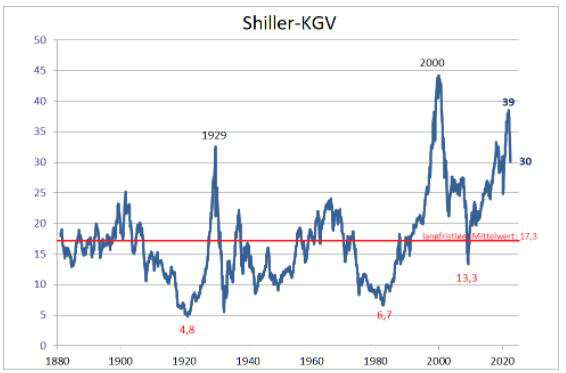How low can the US stock market fall?
Investors should better buckle up: In absolute extreme cases, the S&P 500 could still crash by more than 80 percent.
Are US equities already cheap again after the price losses of recent months? Should we buy stocks again now in order to benefit from a broad recovery movement? Or should we rather be cautious and expect further downward movements? Many investors are currently asking themselves these questions.
In order to assess how “cheap” or “expensive” the US stock market is from a fundamental perspective, the so-called Shiller P/E ratio has proven itself. Like the normal P/E ratio, the Shiller P/E ratio puts the price (in this case, the price of the broad US large-caps index S&P 500) in relation to corporate earnings. In contrast to the normal P/E ratio, however, the Shiller P/E ratio uses the inflation-adjusted average profit of the past ten years.
In boom phases, not only prices, but also corporate profits usually rise to undreamt-of heights, only to fall sharply again in the next crisis. By using the average profit of the past ten years, the Shiller P/E ratio compensates for the fluctuations in corporate earnings caused by the economic cycle.
A look at the course of the Shiller P/E ratio shows how the valuation of the S&P 500 has already been reduced by the recent price slide. Compared to the long-term average, however, the Shiller P/E ratio remains at a very high level.

Due to the recent price slide, the Shiller P/E ratio has already decreased from 39 to about 30. (Based on Thursday evening’s closing price.) However, the valuation remains at a level that has only been reached in three periods over the past 140 years, in the run-up to the Global Economic Crisis from 1929, around the Internet bubble at the turn of the millennium and in the past five years.
If the valuation were to fall back to the long-term average level (Shiller P/E ratio of about 17.3), the S&P 500 would have to fall to around 2264 points, which would correspond to a minus of around 42 percent compared to yesterday’s closing price.

Of course, there is no indication that the US stock market is actually heading back to the levels of past decades in terms of valuation. However, a look at the Shiller P/E ratio shows that, in view of the price losses so far, it is by no means a foregone conclusion that it cannot go significantly lower.
In terms of valuation, there is still a lot of room for manoeuvre on the downside. In extreme cases, the price losses recorded so far in the S&P 500 may have been only the beginning of a much larger downward movement.